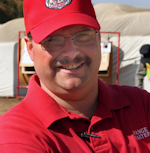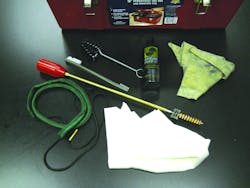Communal Cleaning Kits
It's not a sexy topic, but is one of those issues that Armorers spend a lot of time dealing with. To the gun purest amongst us you may as well offer a classically trained Chef a baloney sandwich then to ask them to clean their guns with a communal kit. So before we get to deep into this discussion let me just say if you do not like the kit at work spend some money and buy your own. This article is from an agency perspective not on what individuals would do on their own. It focuses on getting the job done in a simple strait forward way that minimizes problems that give lazy officers excuses to not maintain their firearms. As the Armorer it has been my job to keep the communal kit clean and stocked with supplies. It sounds simple enough but like most things in the Armory it's not as simple as it seems and like so many other things everyone has a preference and opinion. Just because you know how to shoot does not mean you're qualified to step foot into the armory just as watching CSI does not qualify you to process a crime scene.
Cleaning equipment and supplies make up a lot of what an armory offers to its officers and there are many ways to approach this issue. Some use standard cleaning rods with brushes and patches while others use Otis kits or Bore Snakes. Each system has its pros and cons with valid arguments on both sides.
Traditional cleaning rods with screw on brushes, jags and loops have been around for many years and are viewed as the traditional cleaning kit. Some of the brands of rods and brushes will work together and some will not. This can become a logistical nightmare for the Armorer. Most rifle and handgun cleaning rods are made in 8-32 threads. This includes Otis, Brownells, Dewey and Hoppes. Military rods use 8-36 threads. Adapters are available to convert each to the other thread pitch. My recommendation is to stick with 8-32 as it will give you the most options. The problems with rods for a communal kit is that over the years I have found that small parts of the kit get lost, rods get bent and eventually the kit just gets lost in the bottom of the box the cleaning kit is kept in. I avoid traditional kits whenever I can. My reasons include the logistics involved and the fact that if an officer, who views their gun as just another tool on the belt, goes to the communal kit and cannot locate what they need or finds it inconvenient to clean their gun they tend to just hit the streets with it filthy. If that same officer keeps coming back to the kit and cannot clean their gun because parts are missing or broken they tend to not come back to the kit and heaven only knows when they are going to clean it. I can hear you now "what kind of moron carries a gun for a living and does not take care of it". Well they exist and we have to find ways to encourage them to take care of their gear and eliminating obstacles is a good way to do that.
Otis makes great kits but for a communal kit I find them harder to maintain than traditional rods. This is because the Otis kits are made up of even more small parts and pieces that can get lost or broken. Otis cleaning kits are great if you wish to issue each officer a cleaning kit. They are small, compact and come in their own storage pouch. They contain everything that you need to clean your firearm or firearms. The biggest downside is that Otis kits are expensive when compared to purchasing traditional cleaning supplies or the items I place in our communal kit.
For the last six years my personal favorite solution is the Bore-Snake. I purchased two of them as an experiment when I was with the Sheriff's Department and put them into the communal cleaning kit left in the briefing room. I noticed that the deputies liked using them and it seemed that they were cleaning their guns more often. With time I also noticed that, unlike traditional cleaning rods, parts and pieces to the cleaning kit were not getting lost or damaged. I ended up breaking the kit down to be as simple as possible. This included a Bore-Snake in each caliber of firearm used, a bottle of CLP, a few M16 cleaning brushes and some cleaning rags. When I came to my current Police Department I replicated this cleaning kit. We issue a .40 S&W handgun and an M4 carbine to each officer so our communal kit has .40 and .223 caliber Bore-Snakes, a bottle of CLP that is used to clean and lubricate the firearms, M16 cleaning brushes, and cleaning rags.
One item that I did include to address the large number of M4 carbines in use was a Dewey CHR cleaning rod. This 9 1/2 inch cleaning rod is set up with an M16/AR-15 chamber cleaning brush. My officers use it to clean the locking lug and chamber area that the Bore-Snake does not get into very well. As the Armorer you will need to check the condition of the chamber brush regularly and replace it as needed.
There are those who expressed a dislike for our cleaning kit. One happened to be Vince Bizzini, a man I have a great deal of respect for. He expressed a concern that the Bore-Snake would get dirty with use and that the user would just keep introducing the same filth into the area they are trying to clean. All I can say is that this has not been my experience. As the Armorer it is my job to make sure that the Bore-Snakes are cleaned when needed. What I do to accomplish this is to place the Bore-Snake into a plastic saucer filled with water and detergent and let it soak overnight. The next day I rinse them out and put them into my dish washer in one of those little sacks my wife uses for small items in the laundry. The Bore-Snakes come out clean and once dry they go back into service. From my experience the Bore-Snakes have given us longer service lives than I anticipated. I inspect the imbedded brushes regularly and after 5 years of use none have worn to the point of needing to be replaced. The best part is that none of our Bore-Snakes have any detectable damage nor are any parts missing.
CLP is another issue that has been criticized. I fully agree that there are better products on the market. However, there is a major benefit to using CLP in a communal kit and that is officers cannot screw up and us the wrong liquid to perform a task. Again, I know the gun guys reading this are jumping up and down screaming, "How can you mix that up?" Well I have seen it with my own eyes. By using CLP the officer cleans with the same liquid that they lube the gun with eliminating this issue. When done in conjunctions with annual inspections and deep cleaning with a sonic cleaner, the guns are stripped of any buildup that may occur.
From the top down my current department is made up of shooters. At first they looked at the kit as if something was missing. With time they learned how easy this set up was and have grown to appreciate the simplicity. A few have chosen to clean their guns at home with their own kits and I have no issue with that at all. The point is to get your officers to clean and lube their guns with as little fuss as possible. The easier we as Armorers make it the more likely our officers will perform this necessary maintenance on a regular basis. My solution may not fit your program but it is viable and it has met my goals as an Armorer. Our guns are cleaned and lubed regularly, effectively and efficiently.

Dennis Haworth
Dennis Haworth is a police officer with a California state law enforcement agency. He has been a law enforcement range master and armorer for over a decade. He has served as a police academy instructor and has taught specialized courses on several subject matters. He has been involved in product testing for professional associations, manufacturers and law enforcement agencies. He has a BS in Criminology and an MPA with a specialization in human resources management. Much of his free time is spent as an advisor to the Shooting Sports Club at his local University of California campus.



